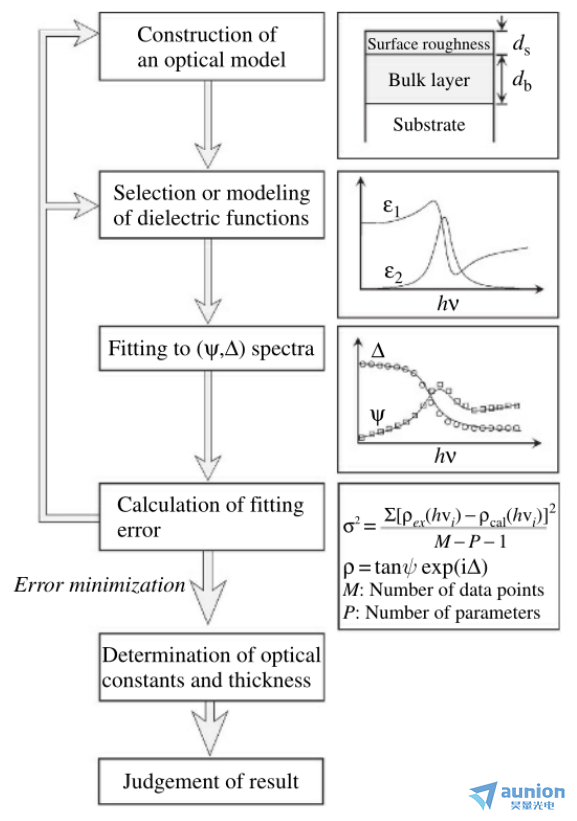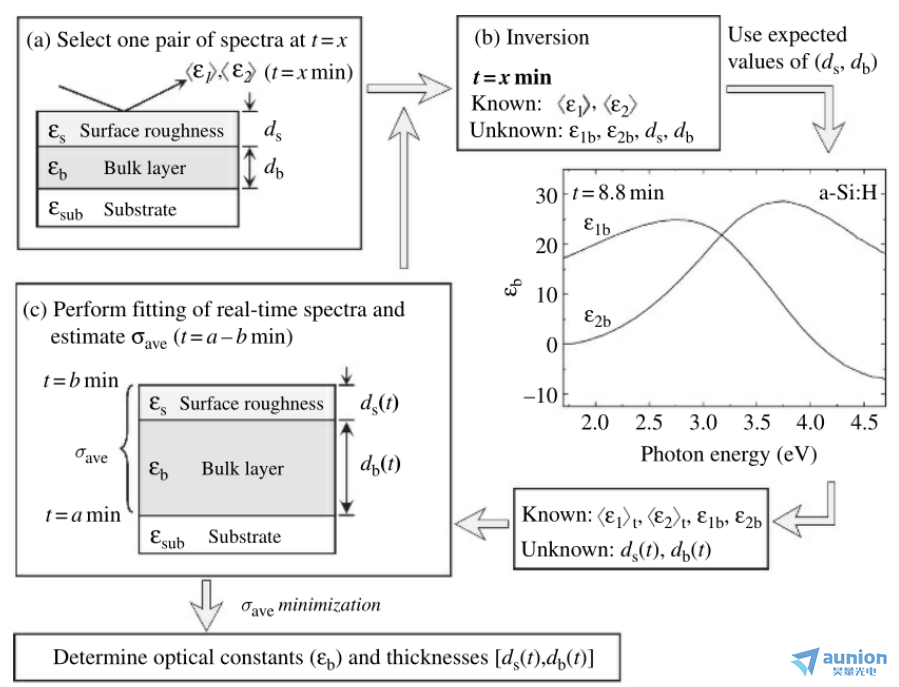

橢偏儀的在位裝置首先要滿足透光,其次是保證工作電極易于調(diào)節(jié)入射光和出射光在同一光平面裹赴,需考慮溶液的光程喜庞,原則上越小越好诀浪,這樣可以減小光的衰減,更易得到沉積薄膜的信息延都。因此需要根據(jù)系統(tǒng)進(jìn)行設(shè)計(jì)雷猪。
展示全部 
橢偏儀在位表征電化學(xué)沉積的系統(tǒng)搭建(九)- 光學(xué)模型的建立與數(shù)據(jù)的提取
4.3在位測試裝置
目前的在位橢偏儀監(jiān)測電化學(xué)沉積的關(guān)鍵在于系統(tǒng)的集成。實(shí)驗(yàn)室的橢偏儀光源為氙燈晰房,可以進(jìn)行全譜的測試求摇,但是這也導(dǎo)致單波長的光強(qiáng)度較弱,因此裝置設(shè)計(jì)中的光路設(shè)計(jì)尤為重要殊者,另外是光斑的大小問題与境,光斑大小會(huì)隨著測試角度的變化而變化。另外其設(shè)計(jì)需要滿足電化學(xué)薄膜沉積的需求猖吴,又要同時(shí)滿足橢偏儀測試的需求摔刁。如作為電解池它需要滿足容電解液充足,且可以放置好工作電極海蔽、對(duì)電極和參比電極共屈。橢偏儀的在位裝置首先要滿足透光,其次是保證工作電極易于調(diào)節(jié)入射光和出射光在同一光平面党窜,需考慮溶液的光程拗引,原則上越小越好,這樣可以減小光的衰減幌衣,更易得到沉積薄膜的信息寺擂。因此需要根據(jù)系統(tǒng)進(jìn)行設(shè)計(jì)。
4.4光學(xué)模型的建立與數(shù)據(jù)的提取
在位橢偏儀測試的另外一個(gè)挑戰(zhàn)在于數(shù)據(jù)的分析泼掠。通過橢偏光譜的在位監(jiān)測可以獲得(ψ怔软,Δ)值,利用這些光譜择镇,需要進(jìn)行建模從而獲取其光學(xué)參數(shù)挡逼。表1-1總結(jié)了在位橢偏儀數(shù)據(jù)分析常用的分析方法。
線性回歸分析(LRA) | 全局誤差zui小化(GEM) | 虛擬襯底近似(VSA) | |
解析條件 | 介電函數(shù)是已知 | 介電函數(shù)與厚度無關(guān) | 薄膜和襯底吸光 |
難易程度 | 容易 | 困難 | 中等 |
介電函數(shù) | 必要 | 非必要 | 必要 |
透明材料分析 | 可以 | 可以 | 不可以 |
梯度層分析 | 困難 | 困難 | 可行 |
實(shí)時(shí)控制 | 可以 | 不可以 | 可以 |
表1-1在位橢偏儀數(shù)據(jù)分析方法
表1-1所示的線性回歸分析(LRA)必須知道樣品所有的介電函數(shù)腻豌,通過擬合得到誤差的zui小值來確定光學(xué)常數(shù)和薄膜結(jié)構(gòu)家坎。當(dāng)樣品中有未知的介電函數(shù)時(shí),需要進(jìn)行介電函數(shù)建模吝梅,使用數(shù)值反演法可以提取樣品的介電函數(shù)虱疏。圖1-17是用LRA橢偏儀數(shù)據(jù)分析的流程圖,可以看出橢偏儀數(shù)據(jù)提取與分析的步驟為:(1)建立適合的光學(xué)模型苏携;(2)確定每一層的介電常數(shù)做瞪;(3)對(duì)橢偏譜譜(ψ,Δ)進(jìn)行擬合;(4)誤差計(jì)算装蓬。通過不斷重復(fù)以上四個(gè)步驟得到zui小誤差著拭,然后進(jìn)行(5)光學(xué)常數(shù)和厚度的測定及(6)結(jié)果可靠性判斷。

圖1-17橢偏光譜法數(shù)據(jù)分析程序流程圖
表1-1中的全局誤差zui小化法(GEM)是Collins團(tuán)隊(duì)開發(fā)的數(shù)據(jù)分析方法牍帚,該方法使我們能夠同時(shí)確定樣品的介電函數(shù)和結(jié)構(gòu)儡遮。因此,當(dāng)樣品的介電函數(shù)未知時(shí)暗赶,GEM是一種相當(dāng)強(qiáng)大的分析方法鄙币。
圖1-18展示了GEM的數(shù)據(jù)分析過程。圖1-18(a)為橢偏譜的光學(xué)模型蹂随。在這個(gè)模型中十嘿, 和
和 分別表示表面粗糙度層、本體層和基底的介電函數(shù)糙及。在分析過程中详幽,先要確定本體層筛欢、基底層的介電常數(shù)浸锨。通常基底層介電函數(shù)可以從薄膜沉積前的(ψ,Δ)光譜使用數(shù)值反演法得到版姑。表面粗糙度層的
分別表示表面粗糙度層、本體層和基底的介電函數(shù)糙及。在分析過程中详幽,先要確定本體層筛欢、基底層的介電常數(shù)浸锨。通常基底層介電函數(shù)可以從薄膜沉積前的(ψ,Δ)光譜使用數(shù)值反演法得到版姑。表面粗糙度層的 由EMA計(jì)算柱搜。如圖1-18(b)所示,該光學(xué)模型中的未知參數(shù)為體積層的介電函數(shù)
由EMA計(jì)算柱搜。如圖1-18(b)所示,該光學(xué)模型中的未知參數(shù)為體積層的介電函數(shù) 表面粗糙度層厚度ds剥险,和本體層厚度db聪蘸。如果
表面粗糙度層厚度ds剥险,和本體層厚度db聪蘸。如果 隨時(shí)間的變化可知,則ds和db可以直接從測量的光譜(ψ,Δ)使用數(shù)值反演得到表制。然后用線性回歸分析健爬,可以確定測量層的光學(xué)常數(shù)和厚度,如圖1-18(b)和(c)所示么介。不斷重復(fù)以上步驟使得誤差小zui娜遵,從而得到材料的光學(xué)常數(shù)和厚度,zui后進(jìn)行結(jié)果的可靠性判斷完成整個(gè)分析過程壤短。
隨時(shí)間的變化可知,則ds和db可以直接從測量的光譜(ψ,Δ)使用數(shù)值反演得到表制。然后用線性回歸分析健爬,可以確定測量層的光學(xué)常數(shù)和厚度,如圖1-18(b)和(c)所示么介。不斷重復(fù)以上步驟使得誤差小zui娜遵,從而得到材料的光學(xué)常數(shù)和厚度,zui后進(jìn)行結(jié)果的可靠性判斷完成整個(gè)分析過程壤短。

圖1-18全局誤差zui小化(GEM)法數(shù)據(jù)分析步驟
表1-1中的虛擬襯底近似法(VSA)设拟,是1993年Aspnes開發(fā)的,其要求薄膜和襯底表現(xiàn)出相對(duì)較大的光吸收久脯。VSA常用于半導(dǎo)體襯底上形成的半導(dǎo)體層纳胧。VSA可以描述介電函數(shù)在厚度方向上連續(xù)變化的梯度層。將VSA應(yīng)用于成分梯度層的分析帘撰,則可以確定每一層的成分跑慕。從VSA中也可以看出晶體體積分?jǐn)?shù)在生長方向上的變化。然而摧找,與LRA和GEM相比相赁,VSA不能應(yīng)用于光吸收較低的樣品相寇。
了解更多橢偏儀詳情,請(qǐng)?jiān)L問上海昊量光電的官方網(wǎng)頁:
http://www.wjjzl.com/three-level-56.html
更多詳情請(qǐng)聯(lián)系昊量光電/歡迎直接聯(lián)系昊量光電
關(guān)于昊量光電:
上海昊量光電設(shè)備有限公司是光電產(chǎn)品專業(yè)代理商钮科,產(chǎn)品包括各類激光器唤衫、光電調(diào)制器、光學(xué)測量設(shè)備绵脯、光學(xué)元件等佳励,涉及應(yīng)用涵蓋了材料加工、光通訊蛆挫、生物醫(yī)療赃承、科學(xué)研究、國防悴侵、量子光學(xué)瞧剖、生物顯微、物聯(lián)傳感可免、激光制造等抓于;可為客戶提供完整的設(shè)備安裝,培訓(xùn)浇借,硬件開發(fā)捉撮,軟件開發(fā),系統(tǒng)集成等服務(wù)妇垢。
您可以通過我們昊量光電的官方網(wǎng)站www.wjjzl.com了解更多的產(chǎn)品信息巾遭,或直接來電咨詢4006-888-532。
相關(guān)文獻(xiàn)
[1] WONG H S P, FRANK D J, SOLOMON P M et al. Nanoscale cmos[J]. Proceedings of the IEEE, 1999, 87(4): 537-570.
[2] LOSURDO M, HINGERL K. ellipsometry at the nanoscale[M]. Springer Heidelberg New York Dordrecht London. 2013.
[3] DYRE J C. Universal low-temperature ac conductivity of macroscopically disordered nonmetals[J]. Physical Review B, 1993, 48(17): 12511-12526. DOI:10.1103/PhysRevB.48.12511.
[4] CHEN S, KüHNE P, STANISHEV V et al. On the anomalous optical conductivity dISPersion of electrically conducting polymers: Ultra-wide spectral range ellipsometry combined with a Drude-Lorentz model[J]. Journal of Materials Chemistry C, 2019, 7(15): 4350-4362.
[5] 陳籃闯估,周巖. 膜厚度測量的橢偏儀法原理分析[J]. 大學(xué)物理實(shí)驗(yàn), 1999, 12(3): 10-13.
[6] ZAPIEN J A, COLLINS R W, MESSIER R. Multichannel ellipsometer for real time spectroscopy of thin film deposition from 1.5 to 6.5 eV[J]. Review of Scientific Instruments, 2000, 71(9): 3451-3460.
[7] DULTSEV F N, KOLOSOVSKY E A. Application of ellipsometry to control the plasmachemical synthesis of thin TiONx layers[J]. Advances in Condensed Matter Physics, 2015, 2015: 1-8.
[8] DULTSEV F N, KOLOSOVSKY E A. Application of ellipsometry to control the plasmachemical synthesis of thin TiONx layers[J]. Advances in Condensed Matter Physics, 2015, 2015: 1-8.
[9] YUAN M, YUAN L, HU Z et al. In Situ Spectroscopic Ellipsometry for Thermochromic CsPbI3 Phase Evolution Portfolio[J]. Journal of Physical Chemistry C, 2020, 124(14): 8008-8014.
[10] 焦楊景.橢偏儀在位表征電化學(xué)沉積的系統(tǒng)搭建.云南大學(xué)說是論文,2022.
[11] CANEPA M, MAIDECCHI G, TOCCAFONDI C et al. Spectroscopic ellipsometry of self assembLED monolayers: Interface effects. the case of phenyl selenide SAMs on gold[J]. Physical Chemistry Chemical Physics, 2013, 15(27): 11559-11565. DOI:10.1039/c3cp51304a.
[12] FUJIWARA H, KONDO M, MATSUDA A. Interface-layer formation in microcrystalline Si:H growth on ZnO substrates studied by real-time spectroscopic ellipsometry and infrared spectroscopy[J]. Journal of Applied Physics, 2003, 93(5): 2400-2409.
[13] FUJIWARA H, TOYOSHIMA Y, KONDO M et al. Interface-layer formation mechanism in (formula presented) thin-film growth studied by real-time spectroscopic ellipsometry and infrared spectroscopy[J]. Physical Review B - Condensed Matter and Materials Physics, 1999, 60(19): 13598-13604.
[14] LEE W K, KO J S. Kinetic model for the simulation of hen egg white lysozyme adsorption at solid/water interface[J]. Korean Journal of Chemical Engineering, 2003, 20(3): 549-553.
[15] STAMATAKI K, PAPADAKIS V, EVEREST M A et al. Monitoring adsorption and sedimentation using evanescent-wave cavity ringdown ellipsometry[J]. Applied Optics, 2013, 52(5): 1086-1093.
[16] VIEGAS D, FERNANDES E, QUEIRóS R et al. Adapting Bobbert-Vlieger model to spectroscopic ellipsometry of gold nanoparticles with bio-organic shells[J]. Biomedical Optics Express, 2017, 8(8): 3538.
[17] ARWIN H. Application of ellipsometry techniques to biological materials[J]. Thin Solid Films, 2011, 519(9): 2589-2592.
[18] ZIMMER A, VEYS-RENAUX D, BROCH L et al. In situ spectroelectrochemical ellipsometry using super continuum white laser: Study of the anodization of magnesium alloy [J]. Journal of Vacuum Science & Technology B, 2019, 37(6): 062911.
[19] ZANGOOIE S, BJORKLUND R, ARWIN H. Water Interaction with Thermally Oxidized Porous Silicon Layers[J]. Journal of The Electrochemical Society, 1997, 144(11): 4027-4035.
[20] KYUNG Y B, LEE S, OH H et al. Determination of the optical functions of various liquids by rotating compensator multichannel spectroscopic ellipsometry[J]. Bulletin of the Korean Chemical Society, 2005, 26(6): 947-951.
[21] OGIEGLO W, VAN DER WERF H, TEMPELMAN K et al. Erratum to ― n-Hexane induced swelling of thin PDMS films under non-equilibrium nanofiltration permeation conditions, resolved by spectroscopic ellipsometry‖ [J. Membr. Sci. 431 (2013), 233-243][J]. Journal of Membrane Science, 2013, 437: 312..
[22] BROCH L, JOHANN L, STEIN N et al. Real time in situ ellipsometric and gravimetric monitoring for electrochemistry experiments[J]. Review of Scientific Instruments, 2007, 78(6).
[23] BISIO F, PRATO M, BARBORINI E et al. Interaction of alkanethiols with nanoporous cluster-assembled Au films[J]. Langmuir, 2011, 27(13): 8371-8376.
[24] 李廣立. 氧化亞銅薄膜的制備及其光電性能研究[D]. 西南交通大學(xué), 2016.
[25] 董金礦. 氧化亞銅薄膜的制備及其光催化性能的研究[D]. 安徽建筑大學(xué), 2014.
[26] 張楨. 氧化亞銅薄膜的電化學(xué)制備及其光催化和光電性能的研究[D]. 上海交通大學(xué)材料科 學(xué)與工程學(xué)院, 2013.
[27] DISSERTATION M. Cellulose Derivative and Lanthanide Complex Thin Film Cellulose Derivative and Lanthanide Complex Thin Film[J]. 2017.
[28] NIE J, YU X, HU D et al. Preparation and Properties of Cu2O/TiO2 heterojunction Nanocomposite for Rhodamine B Degradation under visible light[J]. ChemistrySelect, 2020, 5(27): 8118-8128.
[29] STRASSER P, GLIECH M, KUEHL S et al. Electrochemical processes on solid shaped nanoparticles with defined facets[J]. Chemical Society Reviews, 2018, 47(3): 715-735.
[30] XU Z, CHEN Y, ZHANG Z et al. Progress of research on underpotential deposition——I. Theory of underpotential deposition[J]. Wuli Huaxue Xuebao/ Acta Physico - Chimica Sinica, 2015, 31(7): 1219-1230.
[31] PANGAROV n. Thermodynamics of electrochemical phase formation and underpotential metal deposition[J]. Electrochimica Acta, 1983, 28(6): 763-775.
[32] KAYASTH S. ELECTRODEPOSITION STUDIES OF RARE EARTHS[J]. Methods in Geochemistry and Geophysics, 1972, 6(C): 5-13.
[33] KONDO T, TAKAKUSAGI S, UOSAKI K. Stability of underpotentially deposited Ag layers on a Au(1 1 1) surface studied by surface X-ray scattering[J]. Electrochemistry Communications, 2009, 11(4): 804-807.
[34] GASPAROTTO L H S, BORISENKO N, BOCCHI N et al. In situ STM investigation of the lithium underpotential deposition on Au(111) in the air- and water-stable ionic liquid 1-butyl-1-methylpyrrolidinium bis(trifluoromethylsulfonyl)amide[J]. Physical Chemistry Chemical Physics, 2009, 11(47): 11140-11145.
[35] SARABIA F J, CLIMENT V, FELIU J M. Underpotential deposition of Nickel on platinum single crystal electrodes[J]. Journal of Electroanalytical Chemistry, 2018, 819(V): 391-400.
[36] BARD A J, FAULKNER L R, SWAIN E et al. Fundamentals and Applications[M]. John Wiley & Sons, Inc, 2001.
[37] SCHWEINER F, MAIN J, FELDMAIER M et al. Impact of the valence band structure of Cu2O on excitonic spectra[J]. Physical Review B, 2016, 93(19): 1-16.
[38] XIONG L, HUANG S, YANG X et al. P-Type and n-type Cu2O semiconductor thin films: Controllable preparation by simple solvothermal method and photoelectrochemical properties[J]. Electrochimica Acta, 2011, 56(6): 2735-2739.
[39] KAZIMIERCZUK T, FR?HLICH D, SCHEEL S et al. Giant Rydberg excitons in the copper oxide Cu2O[J]. Nature, 2014, 514(7522): 343-347.
[40] RAEBIGER H, LANY S, ZUNGER A. Origins of the p-type nature and cation deficiency in Cu2 O and related materials[J]. Physical Review B - Condensed Matter and Materials Physics, 2007, 76(4): 1-5.
[41] 舒云. Cu2O薄膜的電化學(xué)制備及其光電化學(xué)性能的研究[D]. 云南大學(xué)物理與天文學(xué)院灼舍,2019.
展示全部 